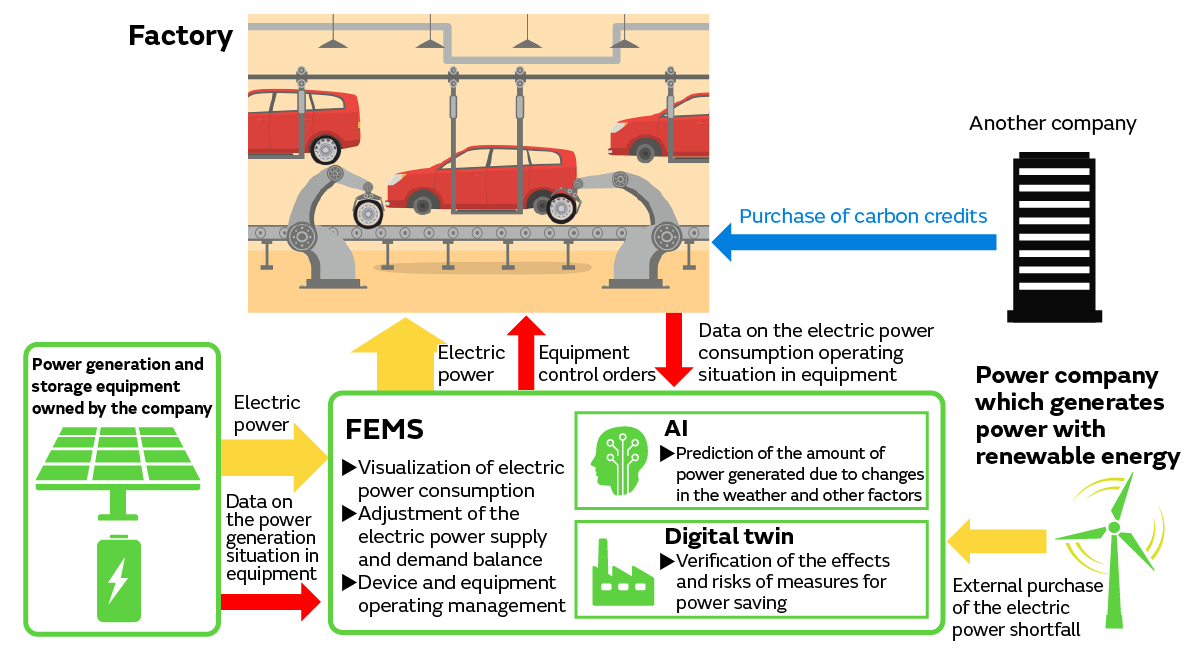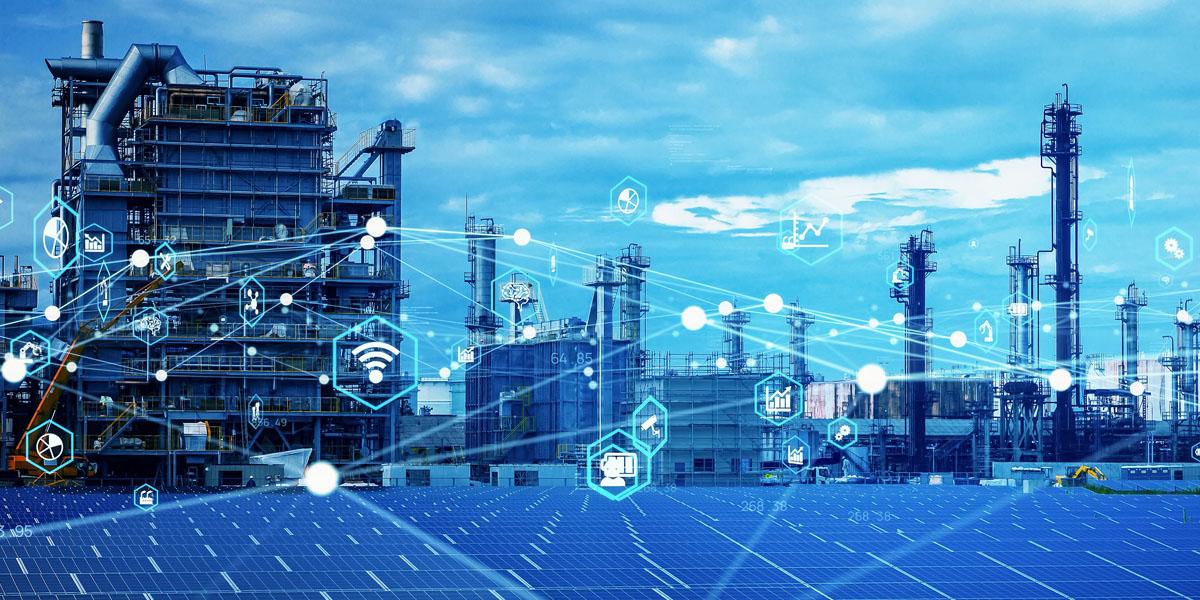The Inseparable Relationship Between Digital Transformation and Decarbonization and Technologies Essential for a Sustainable Manufacturing Industry
Many companies in the manufacturing industry around the world are striving to improve business value and raise operational efficiency through digital transformation (DX). On the other hand, there is now a strong demand for decarbonization efforts, which curb greenhouse gases (GHGs) emitted in production activities to achieve carbon neutrality. The response to these two megatrends of DX and decarbonization has become an important issue in encouraging each company in the manufacturing industry sustainable.
The purpose of decarbonization for the manufacturing industry since 2021 onward has changed from social contribution to achieving profits by observing conditions in transactions with customers and enhancing cost competitiveness. Some leading electronic equipment manufacturers have already stated that they will not procure parts or materials from suppliers that are not striving to reduce GHG emissions. An increasing number of investors are also making proactive decarbonization efforts a condition for investment. Moreover, at the 26th Conference of the Parties to the United Nations Framework Convention on Climate Change (COP26) held in November 2021, the so-called 1.5°C target*1 was raised to a stricter mandatory target. It is increasingly likely that policies with strong binding force will be implemented in the future. Those policies include strengthening environment-related regulations and introducing carbon pricing*2 such as carbon taxes. As a result, decarbonization efforts have become directly linked to companies’ earnings in the manufacturing industry. That means they are starting to have the same meaning as productivity improvements.
*1: This is the target to keep the rise in the global average temperature within 1.5°C compared to before the Industrial Revolution.
*2: This is the general term for the mechanism to pass on a company's CO2 emissions to costs. It includes a tax called a carbon tax imposed on the use of fossil fuels and emissions trading to buy and sell CO2 emission allowances to clear environmental regulations. According to the World Bank, carbon pricing has already been introduced in 46 countries and 35 regions as of April 10, 2021.
The two megatrends surrounding the manufacturing industry of DX and decarbonization appear to be separate trends at first glance. However, in reality, DX leads to more efficient production activities, energy saving, and decarbonization. Therefore, they have an inseparable relationship. We introduce here how to use DX initiatives as a means to promote decarbonization. In particular, we look at the latest trends in the utilization of information processing technologies such as IoT, AI, and digital twins. We then explain decarbonization in smart factories.
Two Approaches to Promoting Decarbonization in Factories
Many machine tools, industrial robots, motor-driven devices and equipment like compressors, electric heaters, control devices, and other devices and equipment operated by electric power are used in factories. The decarbonization of these devices and equipment operated by electric power has become a major issue in the manufacturing industry.
The approaches to decarbonization of devices and equipment that use electric power are broadly divided into two (Fig. 1). One is a method of switching to using sources of energy that do not emit greenhouse gases. Specifically, this includes the utilization of solar power, wind power, and other forms of renewable energy. The other is a method to completely cut out unnecessary power consumption. This is so-called power-saving. Promoting DX is an important condition for pushing ahead with these two approaches.

In general, the amount of electric power obtained from renewable energy is unstable. It depends on the sun and the wind, for example. However, electric power systems must satisfy the principle of electric power supply called the "same amount at the same time" in which the amount of electric power supplied and consumed is constantly kept the same. The reason for this is that if there is a significant difference in the amount of electric power consumed and supplied, an abnormal load may be applied to power generators, power distribution equipment, electrical equipment, and other devices, causing them to fail, or the electric power quality may become unstable. That may cause malfunctions or power outages. In other words, it is necessary to cover only the electric power that corresponds to the amount consumed in the factory with electric power generated at that time, electric power stored in storage batteries, or other sources of electric power.
Aiming for Compliance with RE100 by Utilizing IoT
In recent years, there has been an increasing number of companies in the manufacturing industry joining the RE100 international environmental initiative. This is an initiative aiming to cover the electric power used in business activities with 100% renewable energy. It is important to introduce an electric power system capable of appropriately managing and controlling the electric power supply and demand balance without lowering productivity or quality and a mechanism to cover the shortfall from countermeasures to realize the ideals of RE100 in factories (Fig. 2).

To ensure a factory is compliant with RE100, it is first necessary to build a renewable energy utilization infrastructure by introducing power generation and storage equipment for solar power and other forms of renewable energy. It is also important to have a mechanism to store surplus electric power in storage batteries and to cover the shortfall in electric power by visualizing the amount of electric power generated, which changes moment by moment due to changes in the weather, and the amount of electric power consumed in the factory, which increases or decreases depending on the production activity situation.
There are more and more examples of companies introducing an electric power management system called the Factory Energy Management System (FEMS) in advanced factories. This is a system that utilizes IoT to monitor the amount of electric power consumed. It then adjusts peak electric power, controls the operation of air conditioners, lighting equipment, and production lines according to the situation, and performs other similar operations. The system visualizes the electric power consumption situation across the entire factory. It then curbs the nonessential and nonurgent operation of equipment and minimizes unnecessary electric power consumption without a drop in productivity. The range of equipment managed by the FEMS has now expanded to include power generation and storage equipment. It has evolved to being capable of maintaining the supply and demand balance in RE100-compliant factories.
Highly Accurate Prediction and Management of the Electric Power Supply and Demand Balance with AI and Digital Twins
Attempts are also underway to further raise the accuracy of management and control with the FEMS by utilizing the latest information processing technologies such as AI and digital twins*3.
*3: A digital twin is a digital model that reproduces the same conditions and properties as in the real world by inputting data that reflects the current situation collected by IoT in the design data of real things.
For example, technologies are being developed that estimate the amount of electric power obtained from solar power generation. To achieve this, those technologies analyze weather forecast and past track record data using AI to accurately predict the amount of power generated, which can be obtained from the equipment owned by a company. If it is possible to accurately predict the amount of power generated, it becomes possible to more effectively utilize the electric power generated in a company by shifting the peak of electric power consumption through the adjustment of production plans.
Moreover, digital twins, which reproduce the conditions and movements over an entire factory using a computer, are being built, and technologies that increase the effect of power-saving measures are also being developed. It is becoming possible to take measures that allow the maximum effect to be obtained without risk by verifying on a digital twin the power-saving effect and the impact on productivity and product quality from the changes in the control and operation conditions of devices and equipment and alterations to production plans.
Decarbonization efforts in the manufacturing industry are inseparably related to DX initiatives in factories. Regarding DX-related efforts, it seems important to keep in mind not only productivity and quality improvements, but also decarbonization.
Related articles
- From automation to autonomy and collaboration, manufacturing robots are advancing to become smarter
- Automated Guided Vehicles (AGV) Have Evolved into Smart Autonomous Mobile Robots (AMR) and Are Improving the Efficiency of Operations in Factories
- From Field Networks to TSN: The Evolution of Telecommunications Infrastructure in Factories

